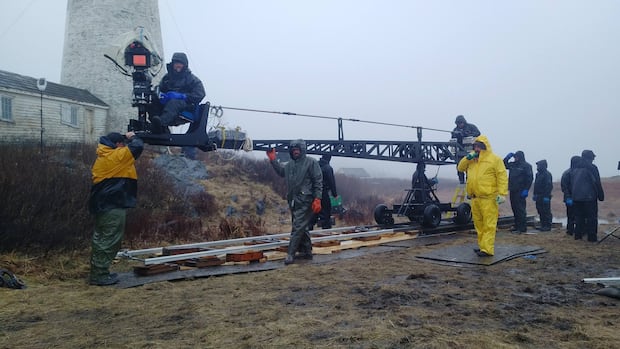N.S. crew members react to The Lighthouse's Oscar nomination
'It was the most challenging film I've ever done as an operator. It pushed my limit right to the end'

Several Nova Scotia crew members who worked on The Lighthouse say the Oscar-nominated film was extremely challenging to shoot, but a thrill to work on.
On Monday, the Yarmouth, N.S.-shot film that stars Willem Dafoe and Robert Pattinson was announced as one of the finalists for best cinematography at the 2020 Academy Awards.
"It was the most challenging film I've ever done as an operator. It pushed my limit right to the end," camera operator Christopher Ball said on CBC's Mainstreet.
"There were shots that were mentally and physically really, really exhausting to get. Some of these setups would be three to four hours in the making for one shot because they were so complicated and so precise."
Unlike most modern movies, which are shot digitally, The Lighthouse was shot on 35-millimetre black-and-white film.
"It's been 10 or 12 years since we've seen these cameras," Eddy McInnis, first assistant camera, noted. "And having Christopher [Ball] there, between the two of us, there's nothing we couldn't figure out or remember."

He said the "discipline of filmmaking" came back during the shoot.
"Cutting, rehearsing, doing things which we kind of lost now in the digital age where we keep rolling, shoot everything," McInnis said.
Ball said the experience "brought me back to film school ... it took me back to the days when we took risks and we tried things."
Co-producer Mike Volpe said director Robert Eggers and cinematographer Jarin Blaschke were so prepared they could take risks.
"They knew the direction, certainly Eggers knew where he wanted to go with it, knew the performances he wanted, knew the look he wanted with Jarin, so I think that gave him the luxury and confidence to take risks," he said.

Another big challenge, Ball noted, was the Yarmouth weather. He said most of the weather seen in the film was the actual weather of the day. And if it wasn't, it was being recreated. There are intense storm scenes in the movie.
"The conditions were awfully tough and there was not a lot of complaining," said Volpe.
Ball submitted a brief behind-the-scenes video from a day on set. It shows a crew member clutching on to an umbrella over gear in some very high winds.
"You're in that wind and rain, and so trying to focus and compose the shots and keep the lenses clean and see through the viewfinder, so there's no errors or problems with the shot, it was a huge challenge."
Volpe said he thinks the Oscar nomination puts Nova Scotia back on the map as a destination to both shoot films and find a skilled crew, especially in the years following Nova Scotia's axing of the film tax credit.

"Everyone knows we have beautiful rugged terrain, that's great. But I think people are starting to understand the depth of crew and experience. And also these guys are humble, not anyone could have done this," he said.
"This is a tough one. This would have been not as good if it were in lesser hands, so we're happy we had seasoned guys that knew what they were doing and did it at such a high level."
With files from CBC Radio's Mainstreet
